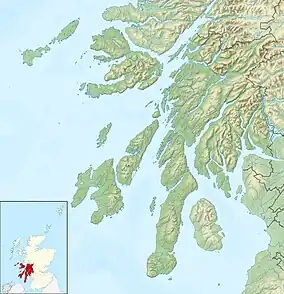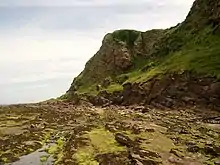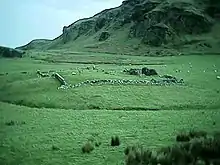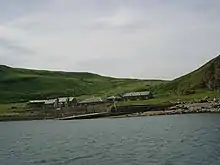| Scottish Gaelic name | Sandaigh/?Abhainn |
|---|---|
| Old Norse name | Sandey/Havn |
| Meaning of name | Sandy Island (Norse) |
| Location | |
 Sanda Island Sanda Island shown within Argyll and Bute | |
| OS grid reference | NR730043 |
| Coordinates | 55°17′N 5°35′W / 55.28°N 5.58°W |
| Physical geography | |
| Island group | Firth of Clyde |
| Area | 127 hectares (0.49 sq mi) |
| Area rank | 131 [1] |
| Highest elevation | 123 metres (404 ft) |
| Administration | |
| Sovereign state | United Kingdom |
| Country | Scotland |
| Council area | Argyll and Bute |
| References | [2][3] |
Sanda Island (Scottish Gaelic: Sandaigh) is a small island in Argyll and Bute, Scotland, off the southern tip of the Kintyre peninsula, near Southend and Dunaverty Castle.
On clear days Sanda can be seen from the southern tip of the Kintyre peninsula, from the Isle of Arran and from northeast County Antrim. It is known locally on Arran and on the Antrim coast as "Spoon Island"[4] because of its resemblance to an upturned spoon.
Population
In the 2001 census Sanda was one of four Scottish islands with a population of just one person. However, since then there has been some development, and in 2008 the island had a population of 3.[5] In August 2008, as a result of their separation, the husband and wife owners put the island up for sale at a price of £3.2 million, and in January 2009 they announced that a sole caretaker would be resident until spring viewings re-commenced.[6] The island was eventually sold to Swiss businessman Michi Meier for the reduced price of £2.5 million. The island's growth as a tourist destination may come to an end under the new owner, who has stated that he wants the island for personal use.[7] By the time of the 2011 census, it had no usual residents.[8]
Wildlife

The island is designated a Site of Special Scientific Interest for its importance for both migrating and breeding birds.[9] Sanda Bird Observatory was the first bird observatory to be set up on the west coast of Scotland.[10]
Geography and geology
According to Haswell-Smith, the island's geology is "lower old red sandstone in red and yellow varieties, and undifferentiated schists."[3]
Sanda lies in the Straits of Moyle (Scottish Gaelic: Sruth na Maoile) between Scotland and Ireland. It is part of a mini-archipelago to the southeast of the Mull of Kintyre, at the far end of the Firth of Clyde. The other islands are Glunimore and Sheep Island, to the north east. Located on the north shore of Sanda is the Oitir Buidhe (yellow sand spit), a pronounced area of sand exposed at low tide, that has two slipways.[11] To the east there is also the notorious "ship catcher", Paterson's Reef.[3]
The island has cliffs on most sides. There are caves on the west coast, and also a couple of natural arches, particularly near "the Ship" as the lighthouse is nicknamed. There are two main hills, in the north west and south east. In between them is a valley which has the double advantage of being sheltered from the prevailing winds and catching the heat of the sun.[3]
History

The island has connections with several well-known historical personages, including the Bruce family, Wallace and Saint Ninian, the first evangeliser north of Hadrian's Wall.
The island is known for the ruins of a chapel built by Saint Ninian, for its Celtic crosses and its reputed holy well.[12] It is said that Ninian was buried here, and indeed, the island was in possession of the Priory of Whithorn in Galloway until the Reformation. It is said that Ninian's grave was marked by an alder tree, and that whoever stepped on it would die.[3]
It was known as "Sandey" (sandy island) by the Norse. This probably refers to the Oitir Buidhe which lies on the north shore of Sanda facing Sheep Island. Another name that appears to have attached itself to the island is Havoin (and numerous variants such as "Aven", "Avona"), which was recorded amongst the "Danish" by Dean Monro in his 16th century Description of the Western Isles of Scotland. This is cognate with the English "haven", and probably refers to the anchorage on the north coast, alternatively, but much less likely, as Haswell-Smith suggests, this could also be a reference to the Scottish Gaelic "abhainn" which means a river.[3]
In the Middle Ages, there was some association with the Bruce family, notably, Robert the Bruce and his brother Edward. Edward lends his name to "Prince Edward's Rock", which is just south of Sanda Lighthouse, and which is nothing to do with Bonnie Prince Charlie, as sometimes thought. Robert was once forced to flee there, en route to Ireland after being pursued by the English navy. He has been sheltering with sympathisers at nearby Dunaverty Castle, on Kintyre in 1306, but was forced to leave. He later sheltered at Rathlin Island, which is less than twenty nautical miles (forty kilometres) away, and which is where he was said to have seen the legendary spider in the cave.[3] In the south are "Wallace's Rocks" which may be linked in legend to William Wallace.
In the later 16th and 17th centuries, the island was connected with the MacDonalds of Kintyre, who sided with Montrose Colkitto married a MacDonald of Sanda;[13] those MacDonalds were also caught up in related fighting from the 1630s onwards, and lost their position as a result of the Dunaverty Massacre.[14]
The island has had a number of different owners in its history, including, in 1969, Jack Bruce of the rock group Cream.
Lighthouse
 Sanda lighthouse, nicknamed "the Ship" | |
| Location | Sanda Island, Argyll and Bute, United Kingdom |
|---|---|
| OS grid | NR7254903715 |
| Coordinates | 55°16′29″N 5°34′58″W / 55.274821°N 5.582836°W |
| Tower | |
| Constructed | 1850 |
| Built by | Alan Stevenson |
| Construction | masonry tower |
| Automated | 1977 |
| Height | 15 m (49 ft) |
| Shape | cylindrical tower with balcony and lantern attached to 1-storey keeper’s house |
| Markings | white tower, black lantern, ochre trim |
| Power source | mains electricity |
| Operator | Northern Lighthouse Board |
| Heritage | category A listed building |
| Light | |
| Focal height | 50 m (160 ft) |
| Range | 15 nmi (28 km; 17 mi) |
| Characteristic | Fl W 10s |

At the southern tip of the island there is a lighthouse built in 1850 by Alan Stevenson.[15][16] When seen from the sea to the south, the natural arch, and the lighthouse on the rock can look like a ship, hence its name "The Ship" on marine charts.
Byron Darnton
A pub was opened in 2003, named Byron Darnton after the vessel which wrecked on the island in 1946. The Byron Darnton was named after an American war correspondent whose son, John Darnton, also became a journalist and wrote of his visit to the island in 2005.
Stamps
Local stamps have been issued for Sanda since 1962. The stamps served the resident staff employed by the Northern Lighthouse Board, the owners and the many visitors to the island who wished to have their mail posted there, and carried to the nearest GPO post box on the mainland.[17]
References
- ↑ Area and population ranks: there are c. 300 islands over 20 ha in extent and 93 permanently inhabited islands were listed in the 2011 census.
- ↑ Anderson, Joseph (Ed.) (1893) Orkneyinga Saga. Translated by Jón A. Hjaltalin & Gilbert Goudie. Edinburgh. James Thin and Mercat Press (1990 reprint). ISBN 0-901824-25-9
- 1 2 3 4 5 6 7 Haswell-Smith, Hamish (2004). The Scottish Islands. Edinburgh: Canongate. pp. 5–8. ISBN 978-1-84195-454-7.
- ↑ "Isle of Arran". Internet Guide to Scotland. Retrieved 7 October 2009.
- ↑ "Sanda Island". sanda-island.co.uk. Archived from the original on 4 August 2008. Retrieved 7 January 2009.
- ↑ "Lone laird guards remote island". The Scotsman. Edinburgh. 7 January 2009.
- ↑ "Tiny island group sells for £2.5m". BBC News. 27 March 2010.
- ↑ National Records of Scotland (15 August 2013). "Appendix 2: Population and households on Scotland's Inhabited Islands" (PDF). Statistical Bulletin: 2011 Census: First Results on Population and Household Estimates for Scotland Release 1C (Part Two) (PDF) (Report). SG/2013/126. Retrieved 14 August 2020.
- ↑ "Sanda Island Bird Observatory". Retrieved 7 October 2009.
- ↑
- ↑ Scotland Places. "William and Caroline: Sanda Harbour, Sanda Island, Firth of Clyde". Retrieved 11 January 2015.
- ↑ Reeves, William, 'On the Island of Sanda', paper read before the Royal Irish Academy on 14 April 1862 (Dublin: 1862) title at google.com
- ↑ "MacDonald05". Retrieved 30 December 2009.; but there are other theories.
- ↑ Alastair Henderson (30 April 1998). "Sanda". Kintyre Antiquarian & Natural History Society. Retrieved 7 October 2009.
- ↑ Rowlett, Russ. "Lighthouses of Scotland: Argyll and Bute". The Lighthouse Directory. University of North Carolina at Chapel Hill. Retrieved 12 May 2016.
- ↑ Sanda Northern Lighthouse Board. Retrieved 12 May 2016
- ↑ "Modern British Local Posts CD Catalogue, 2009 Edition". Phillips. 2003. Archived from the original on 5 September 2008. Retrieved 8 December 2008.